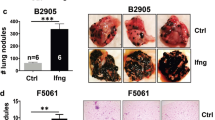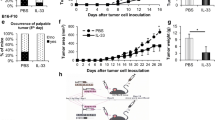Abstract
We previously reported that substantial amounts of IL-10, an immunomodulatory cytokine, are produced by cell suspensions of fresh human metastatic melanoma tissues. Production diminished with continuous culturing of cells, which suggests a pivotal interactive role between melanoma cells and the tumor microenvironment. In this study, we found that the culture media obtained from LPS-stimulated peripheral blood mononuclear cells induced IL-10 production by metastatic melanoma cells. Of the multiple cytokines present in the conditioned culture media, IL-6 was identified as the inducer of IL-10 production. A neutralizing antibody against IL-6 completely blocked the conditioned medium-induced IL-10 production. Metastatic melanoma cells that constitutively produce low amount of IL-10 increased IL-10 production in response to recombinant human IL-6 in a dose-dependent fashion. The response to exogenously added IL-6 was less significant in melanoma cells that produced high amounts of IL-6, probably due to pre-existing autocrine stimulation of IL-10 by endogenous IL-6. On the other hand, metastatic melanoma cells that do not constitutively produce IL-10 protein did not respond to exogenous IL-6. In IL-6-responsive melanoma cells, IL-6 increased STAT3 phosphorylation and inhibition of STAT3 signaling using siRNA or inhibitors for JAKs diminished IL-6-induced IL-10 production. In addition, inhibition of MEK and PI3K, but not mTOR, interfered with IL-10 production. Taken together, the data suggest that blocking of these signals leading to IL-10 production is a potential strategy to enhance an anti-melanoma immune response in metastatic melanoma.






Similar content being viewed by others
References
Colombo MP, Mantovani A (2005) Targeting myelomonocytic cells to revert inflammation-dependent cancer promotion. Cancer Res 65:9113–9116
Gabrilovich DI, Chen HL, Girgis KR et al (1996) Production of vascular endothelial growth factor by human tumors inhibits the functional maturation of dendritic cells. Nat Med 2:1096–1103
Moore KW, O’Garra A, de Waal Malefyt R, Vieira P, Mosmann TR (1993) Interleukin-10. Annu Rev Immunol 11:165–190
Asadullah K, Sterry W, Volk HD (2003) Interleukin-10 therapy—review of a new approach. Pharmacol Rev 55:241–269
Pestka S, Krause CD, Sarkar D, Walter MR, Shi Y, Fisher PB (2004) Interleukin-10 and related cytokines and receptors. Annu Rev Immunol 22:929–979
Lattime EC, Mastrangelo MJ, Bagasra O, Li W, Berd D (1995) Expression of cytokine mRNA in human melanoma tissues. Cancer Immunol Immunother 41:151–156
Sato T, McCue P, Masuoka K et al (1996) Interleukin 10 production by human melanoma. Clin Cancer Res 2:1383–1390
Kim J, Modlin RL, Moy RL et al (1995) IL-10 production in cutaneous basal and squamous cell carcinomas. A mechanism for evading the local T cell immune response. J Immunol 155:2240–2247
Ordemann J, Jacobi CA, Braumann C, Schwenk W, Volk HD, Muller JM (2002) Immunomodulatory changes in patients with colorectal cancer. Int J Colorectal Dis 17:37–41
Knoefel B, Nuske K, Steiner T et al (1997) Renal cell carcinomas produce IL-6, IL-10, IL-11, and TGF-beta 1 in primary cultures and modulate T lymphocyte blast transformation. J Interferon Cytokine Res 17:95–102
Green AR, Green VL, White MC, Speirs V (1997) Expression of cytokine messenger RNA in normal and neoplastic human breast tissue: identification of interleukin-8 as a potential regulatory factor in breast tumours. Int J Cancer 72:937–941
Dummer W, Becker JC, Schwaaf A, Leverkus M, Moll T, Brocker EB (1995) Elevated serum levels of interleukin-10 in patients with metastatic malignant melanoma. Melanoma Res 5:67–68
Nacinovic-Duletic A, Stifter S, Dvornik S, Skunca Z, Jonjic N (2008) Correlation of serum IL-6, IL-8 and IL-10 levels with clinicopathological features and prognosis in patients with diffuse large B-cell lymphoma. Int J Lab Hematol 30:230–239
Guney N, Soydinc HO, Basaran M et al (2009) Serum levels of interleukin-6 and interleukin-10 in Turkish patients with aggressive non-Hodgkin’s lymphoma. Asian Pac J Cancer Prev 10:669–674
Mapara MY, Sykes M (2004) Tolerance and cancer: mechanisms of tumor evasion and strategies for breaking tolerance. J Clin Oncol 22:1136–1151
Berd D, Sato T, Maguire HC Jr, Kairys J, Mastrangelo MJ (2004) Immunopharmacologic analysis of an autologous, hapten-modified human melanoma vaccine. J Clin Oncol 22:403–415
Berd D, Maguire HC Jr, Schuchter LM et al (1997) Autologous hapten-modified melanoma vaccine as postsurgical adjuvant treatment after resection of nodal metastases. J Clin Oncol 15:2359–2370
Berd D, Maguire HC Jr, Mastrangelo MJ (1986) Induction of cell-mediated immunity to autologous melanoma cells and regression of metastases after treatment with a melanoma cell vaccine preceded by cyclophosphamide. Cancer Res 46:2572–2577
Galizia G, Orditura M, Romano C et al (2002) Prognostic significance of circulating IL-10 and IL-6 serum levels in colon cancer patients undergoing surgery. Clin Immunol 102:169–178
Negrier S, Perol D, Menetrier-Caux C et al (2004) Interleukin-6, interleukin-10, and vascular endothelial growth factor in metastatic renal cell carcinoma: prognostic value of interleukin-6–from the Groupe Francais d’Immunotherapie. J Clin Oncol 22:2371–2378
Porta C, De Amici M, Quaglini S et al (2008) Circulating interleukin-6 as a tumor marker for hepatocellular carcinoma. Ann Oncol 19:353–358
Mouawad R, Benhammouda A, Rixe O et al (1996) Endogenous interleukin 6 levels in patients with metastatic malignant melanoma: correlation with tumor burden. Clin Cancer Res 2:1405–1409
Taga T, Hibi M, Hirata Y et al (1989) Interleukin-6 triggers the association of its receptor with a possible signal transducer, gp130. Cell 58:573–581
Mackiewicz A, Schooltink H, Heinrich PC, Rose-John S (1992) Complex of soluble human IL-6-receptor/IL-6 up-regulates expression of acute-phase proteins. J Immunol 149:2021–2027
Oh JW, Revel M, Chebath J (1996) A soluble interleukin 6 receptor isolated from conditioned medium of human breast cancer cells is encoded by a differentially spliced mRNA. Cytokine 8:401–409
Muller-Newen G, Kuster A, Hemmann U et al (1998) Soluble IL-6 receptor potentiates the antagonistic activity of soluble gp130 on IL-6 responses. J Immunol 161:6347–6355
Winston LA, Hunter T (1995) JAK2, Ras, and Raf are required for activation of extracellular signal-regulated kinase/mitogen-activated protein kinase by growth hormone. J Biol Chem 270:30837–30840
Taga T, Kishimoto T (1997) Gp130 and the interleukin-6 family of cytokines. Annu Rev Immunol 15:797–819
Heinrich PC, Behrmann I, Haan S, Hermanns HM, Muller-Newen G, Schaper F (2003) Principles of interleukin (IL)-6-type cytokine signalling and its regulation. Biochem J 374:1–20
Lucas M, Zhang X, Prasanna V, Mosser DM (2005) ERK activation following macrophage FcgammaR ligation leads to chromatin modifications at the IL-10 locus. J Immunol 175:469–477
Brose MS, Volpe P, Feldman M et al (2002) BRAF and RAS mutations in human lung cancer and melanoma. Cancer Res 62:6997–7000
Wan PT, Garnett MJ, Roe SM et al (2004) Mechanism of activation of the RAF-ERK signaling pathway by oncogenic mutations of B-RAF. Cell 116:855–867
Goodall J, Wellbrock C, Dexter TJ, Roberts K, Marais R, Goding CR (2004) The Brn-2 transcription factor links activated BRAF to melanoma proliferation. Mol Cell Biol 24:2923–2931
Sumimoto H, Imabayashi F, Iwata T, Kawakami Y (2006) The BRAF-MAPK signaling pathway is essential for cancer-immune evasion in human melanoma cells. J Exp Med 203:1651–1656
Terai M, Tamura Y, Alexeev V et al (2009) Human interleukin 10 receptor 1/IgG1-Fc fusion proteins: immunoadhesins for human IL-10 with therapeutic potential. Cancer Immunol Immunother 58:1307–1317
Acknowledgments
We thank Dr. Andrew Aplin at Kimmel Cancer Center of Thomas Jefferson University and Dr. Matthew J. McGinniss at Caris Life Sciences for analysis of BRAF and NRAS mutations on melanoma cell lines. We also thank Dr. Henry C. Maguire, Jr. for critical review of this article. This research was supported by the Bonnie Kroll Research Fund, the Marla Brecher Research Fund, and the Eye Melanoma Research Fund at Thomas Jefferson University. M Eto and G. D. Young were supported by a Pennsylvania CURE grant.
Conflicts of Interest
No potential conflicts of interest were disclosed.
Author information
Authors and Affiliations
Corresponding author
Rights and permissions
About this article
Cite this article
Terai, M., Eto, M., Young, G.D. et al. Interleukin 6 mediates production of interleukin 10 in metastatic melanoma. Cancer Immunol Immunother 61, 145–155 (2012). https://doi.org/10.1007/s00262-011-1084-5
Received:
Accepted:
Published:
Issue Date:
DOI: https://doi.org/10.1007/s00262-011-1084-5




